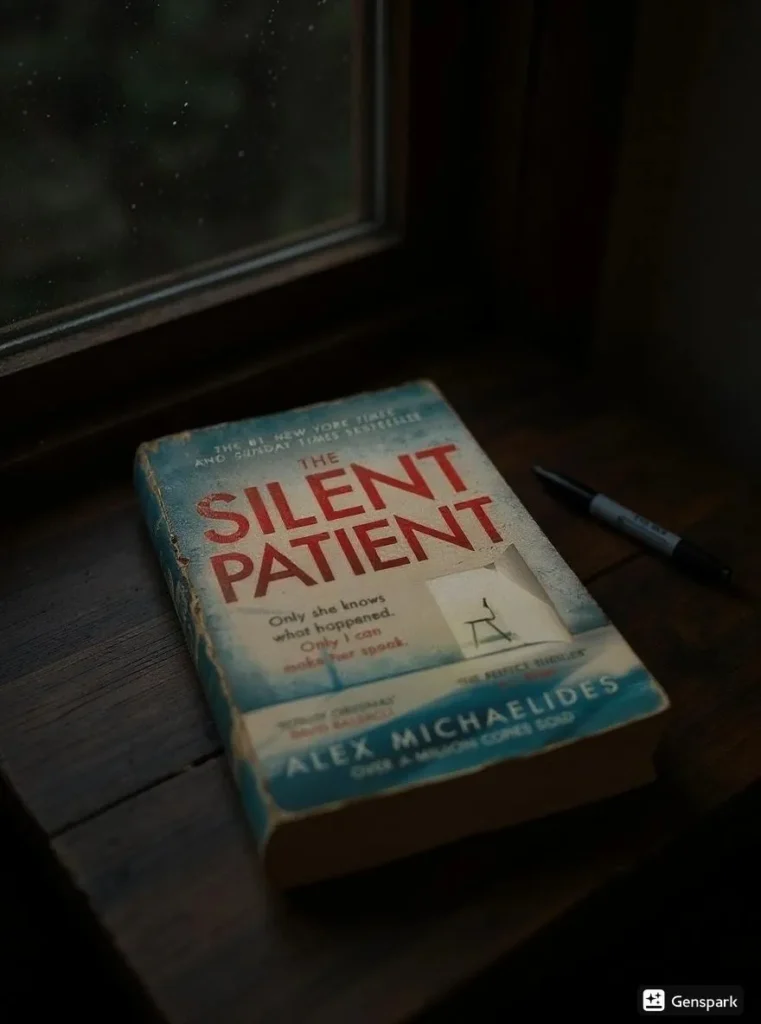I grabbed The Silent Patient from my bedside table at 1:43 AM on a rainy October night, expecting another predictable psychological thriller. I closed it six hours later with shaking hands, my coffee cold and forgotten, staring at the final page in stunned silence. The rain had stopped, but I felt like my brain was still processing the storm that just hit.
Alex Michaelides’ debut became the biggest-selling debut novel worldwide in 2019, selling over 6.5 million copies. After experiencing this book’s mind-bending finale, I understand why readers devoured it like literary crack. The story follows Alicia Berenson, who murdered her husband and refuses to speak, and Theo Faber, the psychotherapist obsessed with her silence.
I’ve read 400+ psychological thrillers in my twenty years of reviewing, and I can tell you this book rewrites the rules of unreliable narration. Michaelides studied psychotherapy for three years and worked at a mental health facility, bringing authentic psychological depth that most thriller writers fake badly.
I picked this book because silence fascinated me. What makes someone choose muteness over explanation? These questions haunted me during those quiet predawn hours when shadows danced and my house creaked ominously around me.
Key Takeaways
Therapeutic relationships become dangerous when therapists project their unresolved trauma onto patients, turning healing into harm through corrupted professional boundaries and personal obsession.
Greek mythology serves as a haunting framework for modern psychological trauma, with the Alcestis story providing layers of meaning about sacrifice, love, and the prices people pay for their deepest choices.
Art functions as both weapon and witness in traumatic situations, with paintings serving as silent testimony to truths too painful for spoken words, proving creative expression can communicate when voices fail.
Childhood trauma creates devastating ripple effects across decades, manifesting in destructive adult patterns that contaminate even professional helping relationships meant to provide healing.
Silence operates as both protection and punishment, challenging traditional communication while revealing how the most powerful statements sometimes emerge from the complete absence of words.
Basic Book Details
Publishing Information: February 5, 2019 by Celadon Books
Genre: Psychological Thriller
Plot: Woman murders husband and maintains complete silence; obsessed psychotherapist determined to make her speak
Series Information: Standalone novel
Page Count: 336 pages
Main Characters:
- Alicia Berenson: Artist who shot her husband Gabriel and hasn’t spoken since
- Theo Faber: Psychotherapist with dangerous personal investment in Alicia’s case
- Gabriel Berenson: Murdered fashion photographer husband
- Kathy Faber: Theo’s wife having an affair with his cousin
- Christian Faber: Theo’s cousin and Kathy’s secret lover
Introduction and Author Background Analysis
Michaelides worked as a failed screenwriter before turning to novels. His films “went from bad to worse,” with one never released and another having only brief theatrical runs. This cinematic failure became his literary triumph. His screenwriting background shows in every carefully constructed scene.
I noticed how each chapter feels like a movie frame, building tension through visual storytelling rather than endless exposition. The dialogue crackles with subtext, making every conversation feel loaded with hidden meaning.
The novel spent over a year on the New York Times bestseller list, positioning itself perfectly between literary fiction and commercial thriller. Michaelides’ psychology background—three years of study plus two years working with adolescents in mental health services—gives the book credibility that separates it from typical genre fiction.
Plot Architecture and Narrative Construction
Michaelides structures his story like a clinical case study, alternating between Theo’s present-day therapy sessions and Alicia’s diary entries from before the murder. This dual timeline creates mounting dread as you piece together fragments of truth.
I found myself constantly flipping back to earlier chapters, hunting for clues I’d missed. The author plants seeds in innocent passages that bloom into devastating revelations later. This technique kept me reading until sunrise, desperate to understand how the pieces connected.
The diary entries feel painfully authentic, capturing a woman’s descent into paranoia and confusion. Michaelides avoids making these entries too convenient, instead showing Alicia’s growing psychological crisis in realistic, disturbing detail.
The classical framework elevates this beyond typical domestic thriller territory. The Alcestis parallel becomes more complex as the story progresses, revealing layers about love, sacrifice, and the twisted modern interpretation of mythic themes.
Character Psychology and Development Examination
Alicia’s silence becomes the book’s most powerful character. Her muteness isn’t passive—it’s an active choice driving every other character’s actions. I was fascinated by how Michaelides makes her voicelessness scream volumes about trauma’s impact on human communication.
Her paintings serve as her voice, particularly the self-portrait titled “Alcestis” created after Gabriel’s murder. This artwork functions as evidence, confession, and prophecy simultaneously. The symbolic use of art adds profound depth to what could have been simple crime fiction.
The author avoids romanticizing mental illness, instead showing how trauma fragments identity and communication. Alicia’s silence protects her while simultaneously inflicting pain on others, creating complex moral territory.
Theo emerges as one of literature’s most disturbing unreliable narrators, though this revelation unfolds gradually. His obsession with Alicia stems from personal trauma he refuses to acknowledge, making his therapeutic approach dangerous rather than healing.
The author’s psychology background shows in his authentic portrayal of therapeutic relationships, particularly how easily professional boundaries collapse when personal issues remain unresolved. Theo’s manipulation of Alicia and other characters feels chillingly realistic.
Literary Techniques and Writing Craft Analysis
Michaelides demonstrates sophisticated understanding of countertransference—when therapists project their issues onto patients. Theo’s treatment of Alicia becomes contaminated by his personal trauma, creating a dangerous therapeutic dynamic that feels authentic rather than contrived.
The exploration of how unresolved childhood trauma affects adult relationships and professional judgment runs throughout the narrative. Theo’s inability to process his own pain makes him incapable of helping Alicia heal, turning therapy into another form of abuse.
Visual art functions as secondary language throughout the novel. Alicia’s paintings communicate what her voice cannot, while classical art references provide thematic depth. The Alcestis painting becomes key evidence and a window into her psyche.
Michaelides uses silence as both weapon and shield. Characters weaponize quiet moments, use silence to torture others, and find protection in refusing to speak. This exploration of communication’s absence creates unique narrative tension I haven’t encountered elsewhere.

Thematic Depth and Cultural Commentary
The novel examines how childhood abuse creates cycles of violence spanning generations. Both Theo and Alicia carry wounds from youth that influence their adult choices, particularly their capacity for healthy relationships.
Michaelides critiques the mental health system’s potential for harm when practitioners bring unresolved issues into treatment. The book raises disturbing questions about who monitors the monitors and how therapeutic relationships can become exploitative.
The Grove, where Alicia receives treatment, becomes a character itself—a place where healing and harm coexist uncomfortably. The institutional setting feels realistic and concerning.
The story explores how women’s voices get silenced, dismissed, or ignored in domestic and institutional settings. Alicia’s refusal to speak becomes resistance against systems that consistently failed to protect her.
Male characters consistently misinterpret or project onto female characters, revealing how gender dynamics influence perception and treatment. Theo’s obsession with “curing” Alicia reflects broader patterns of male control over female narratives.
Genre Innovation and Comparative Literary Analysis
The Silent Patient occupies unique space in psychological thriller territory, combining medical drama, domestic noir, and classical tragedy. This genre-blending influenced subsequent thrillers to incorporate more sophisticated psychological elements.
The book’s success proved readers hunger for complex psychological narratives that challenge rather than simply entertain. It elevated expectations for character development and thematic depth in commercial fiction.
Like Flynn’s Gone Girl, this novel features unreliable narrators exploring marriage’s dark underbelly. But Michaelides focuses more on therapeutic relationships and institutional power dynamics than media manipulation.
Unlike Hawkins’ The Girl on the Train, which relies on alcohol-induced unreliability, The Silent Patient uses psychological trauma and professional obsession to create narrative uncertainty. The medical setting provides unique misdirection opportunities.
Both comparison novels feature women whose voices are doubted or dismissed, but Alicia’s complete silence creates different narrative possibilities. Her muteness becomes more powerful than Amy’s lies or Rachel’s confused memories.
Pros
The psychological authenticity sets this apart from typical thrillers. Michaelides’ mental health background provides credible insight into therapeutic relationships and institutional dynamics that feel genuine rather than researched.
The plot construction is masterful—every detail serves the final revelation. Upon re-reading, I discovered clues hidden in plain sight that completely recontextualize earlier scenes. This replay value distinguishes it from one-trick thrillers.
Character development exceeds genre expectations, particularly showing how trauma shapes behavior across time. The psychological complexity of both Theo and Alicia creates genuine investment beyond simple plot curiosity.
The writing balances accessibility with sophistication, making complex psychological concepts understandable without oversimplification. Michaelides trusts readers to follow intricate emotional and psychological logic.
Cons
The pacing drags during middle sections as Theo conducts repetitive therapy sessions. Some readers may find the institutional setting monotonous compared to domestic drama elements.
Certain plot conveniences strain credibility, particularly regarding professional ethics and institutional oversight. The ease with which Theo manipulates systems occasionally feels contrived.
The shocking ending may frustrate readers seeking traditional resolution. Final revelations raise new questions about character motivations that the narrative doesn’t fully address.
Some secondary characters feel underdeveloped, existing primarily to serve plot functions rather than as fully realized individuals. This is particularly noticeable with Grove staff members.
Final Verdict
The Silent Patient succeeds as both psychological character study and commercial thriller—a rare achievement. The novel focuses on internal landscapes rather than external action, creating lasting impact beyond plot machinations.
The exploration of silence as communication, trauma as inheritance, and therapy as potential harm stayed with me weeks after finishing. I found myself questioning how we listen to or silence marginalized voices in our own lives.
The shocking finale works because it emerges from character psychology rather than arbitrary plot twists. The revelation reframes the entire narrative, making immediate re-reading almost mandatory to appreciate the author’s craft.
This exceptional debut announces Michaelides as a major voice in psychological fiction. Despite minor pacing issues and plot conveniences, it stands among the stronger psychological thrillers of recent years.
Dionysus Reviews Rating: 7/10
Sip The Unknown—Discover Stories You Never Knew You’d Love!
Dionysus Reviews Has A Book For Every Mood
Biography & Memoir
Fiction
Mystery & Detective
Nonfiction
Philosophy
Psychology
Romance
Science Fiction & Fantasy
Teens & Young Adult
Thriller & Suspense
Frequently Asked Questions
What psychological techniques does Theo use to manipulate Alicia and why do they backfire so catastrophically?
Theo employs classic manipulation tactics including isolation, creating dependency, and exploiting trauma bonds—but his techniques backfire because they’re contaminated by his own unresolved issues. He uses therapeutic authority to gain access to Alicia while secretly orchestrating situations that make her more vulnerable to his influence.
The catastrophic failure occurs because his manipulation serves his psychological needs rather than her healing, turning therapy into another form of abuse that ultimately exposes his own crimes.
How does the Alcestis painting function as both confession and misdirection throughout the story?
The Alcestis painting operates on multiple symbolic levels—initially appearing to show Alicia as the sacrificial wife from Greek mythology, but actually encoding the truth about Theo’s role in her trauma. The painting serves as Alicia’s silent confession while simultaneously misdirecting readers and characters about who the real victim and perpetrator are.
The classical reference masks the contemporary psychological horror, with Alicia using mythological symbolism to communicate truths she cannot speak aloud.
Why does Michaelides choose complete silence rather than selective mutism or other forms of communication difficulty?
Complete silence creates absolute narrative power—it forces every other character to project their own interpretations onto Alicia while giving her total control over information flow. Selective mutism would suggest she could speak but chooses not to in certain situations, which would imply different psychological mechanisms.
Total silence becomes both her protection and weapon, preventing further harm while simultaneously punishing those around her. It also creates unique reader engagement, as we must interpret her actions and art rather than relying on her words.
How does the dual timeline structure specifically serve the unreliable narrator reveal?
The alternating timelines allow Michaelides to control information revelation while building false reader sympathy for Theo. By showing his “dedicated” therapeutic work in the present while revealing Alicia’s perspective from the past, the structure creates cognitive dissonance that mirrors real-world manipulation tactics.
The diary entries seem to support Theo’s version of events until the final revelation recontextualizes everything, showing how the timeline structure itself was part of the misdirection.
What makes Theo’s obsession with Alicia different from typical “savior complex” narratives in psychological thrillers?
Theo’s obsession differs because it’s rooted in guilt and self-preservation rather than genuine desire to help. Unlike typical savior complex stories where the helper has pure but misguided intentions, Theo’s motivation is entirely selfish—he needs Alicia to remain silent to protect himself.
His therapeutic efforts are actually elaborate manipulation designed to control rather than cure her, making him simultaneously the supposed healer and the original source of her trauma. This inversion of the helper-victim dynamic creates a more disturbing and realistic portrayal of how power can be abused in therapeutic relationships.









